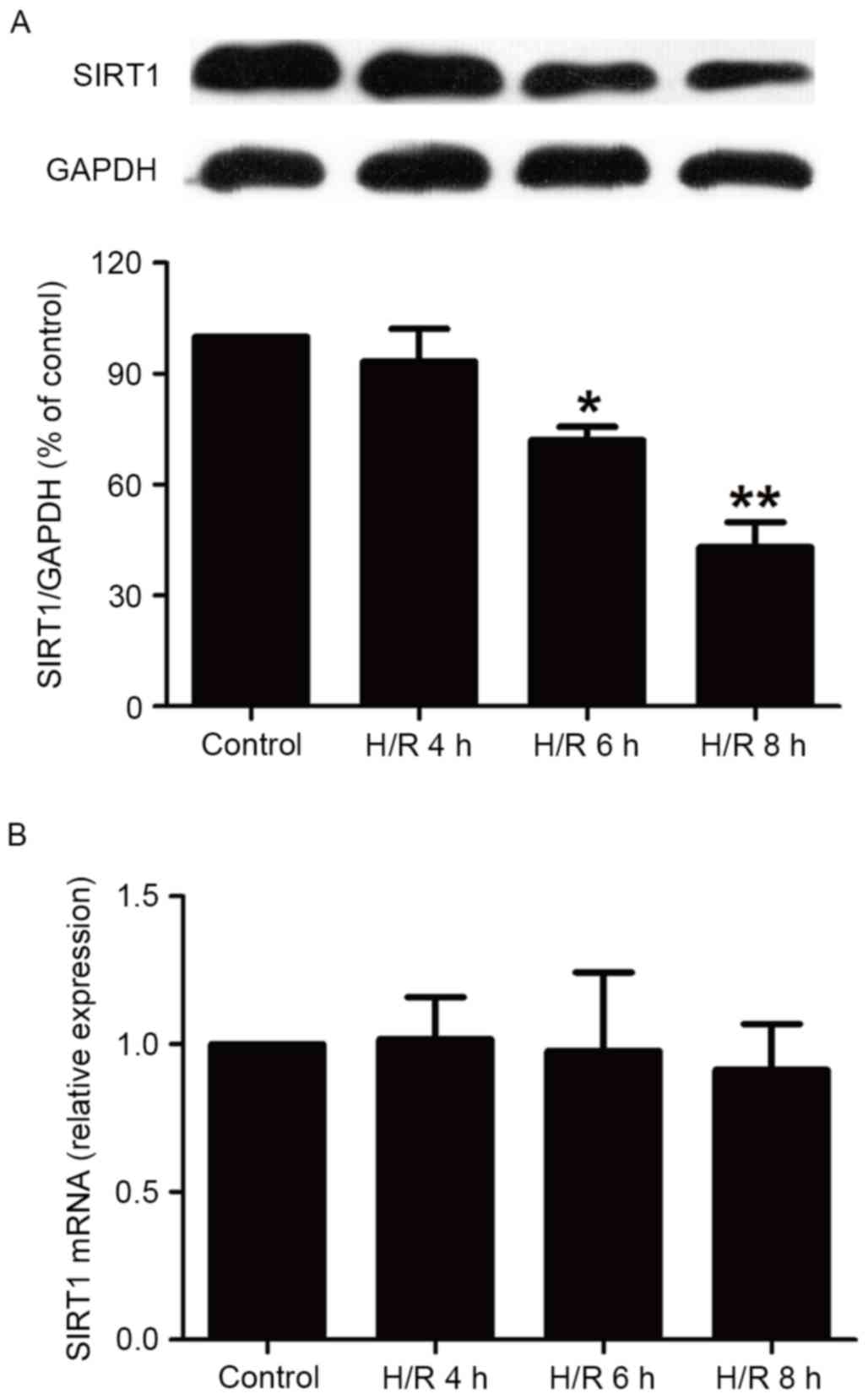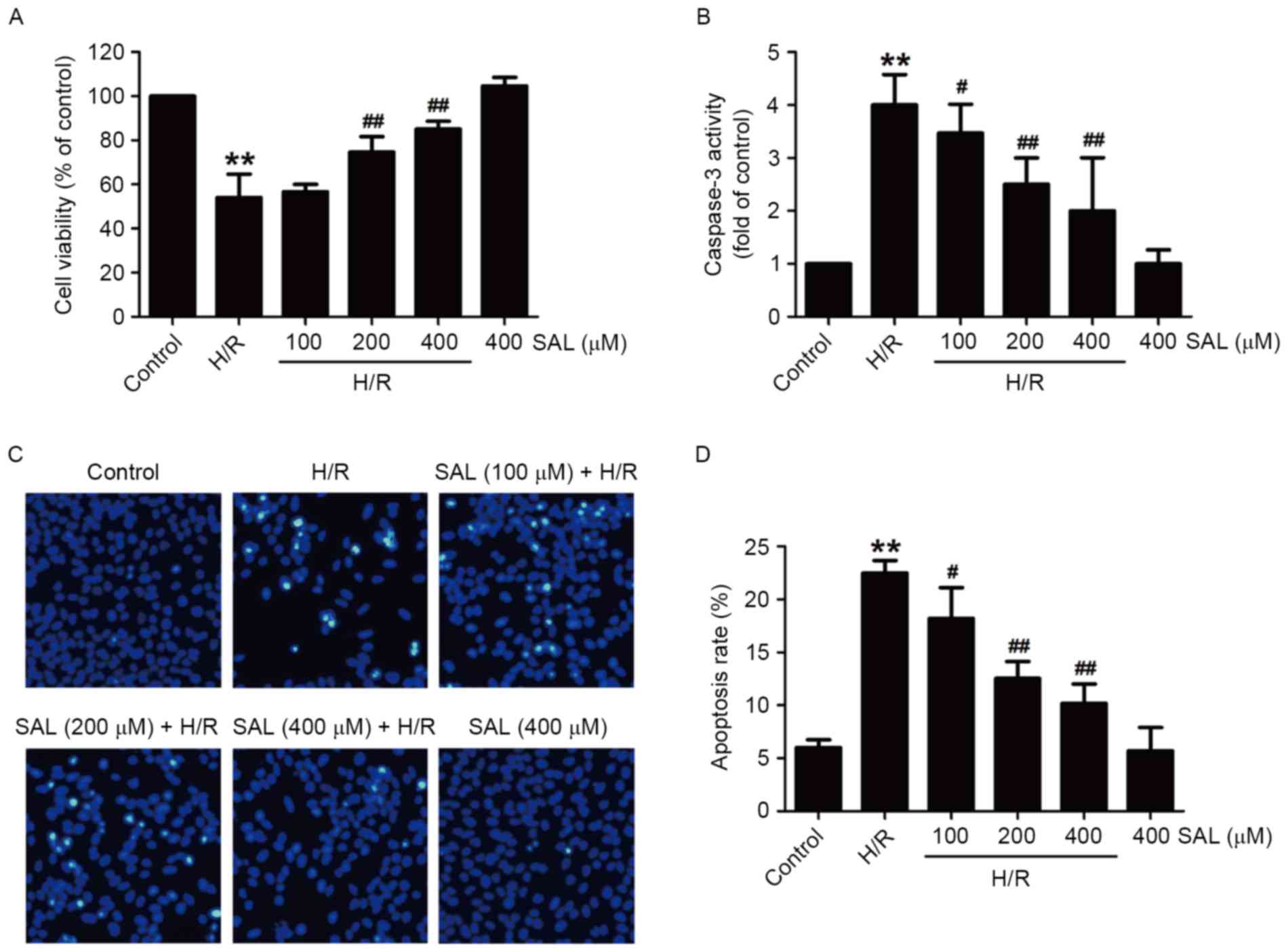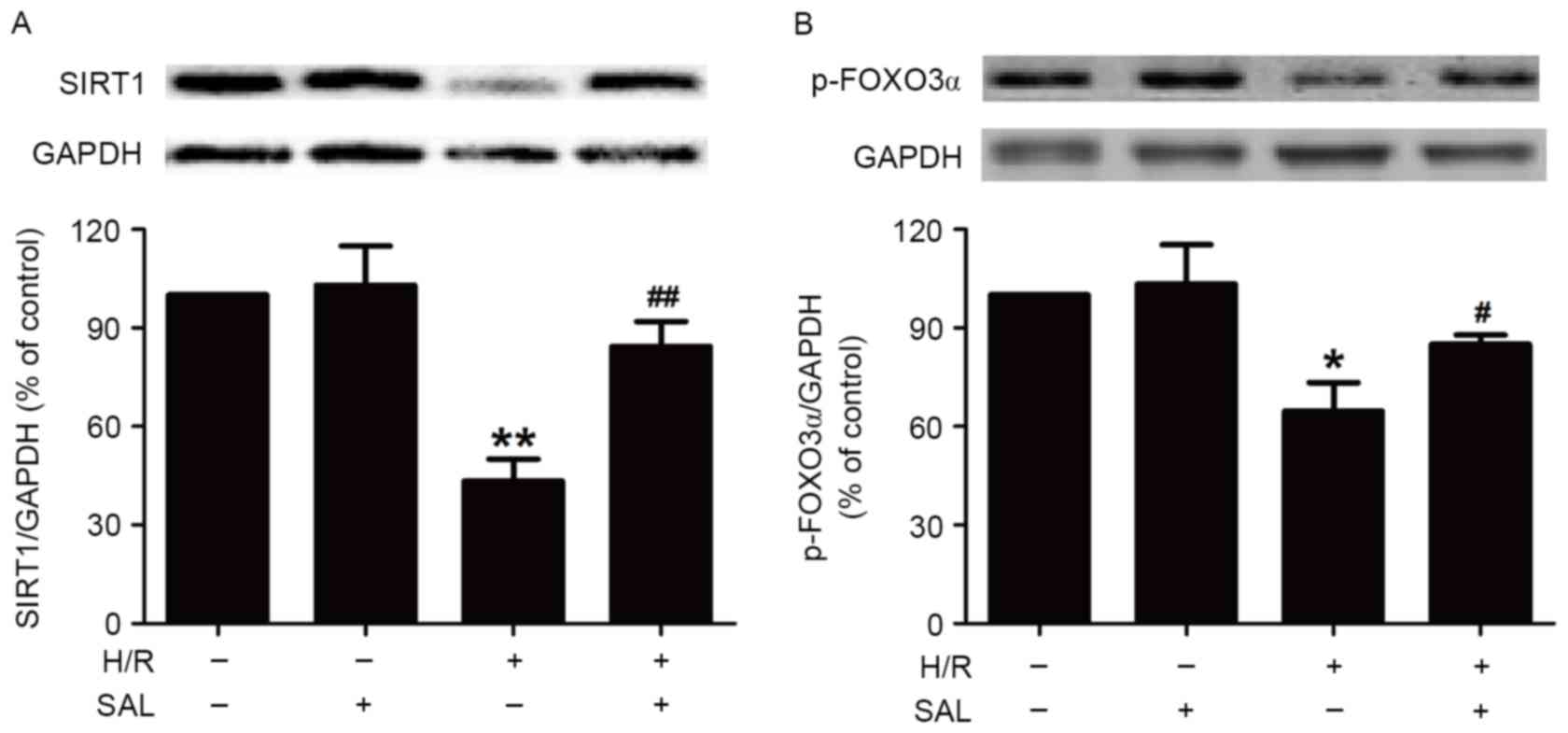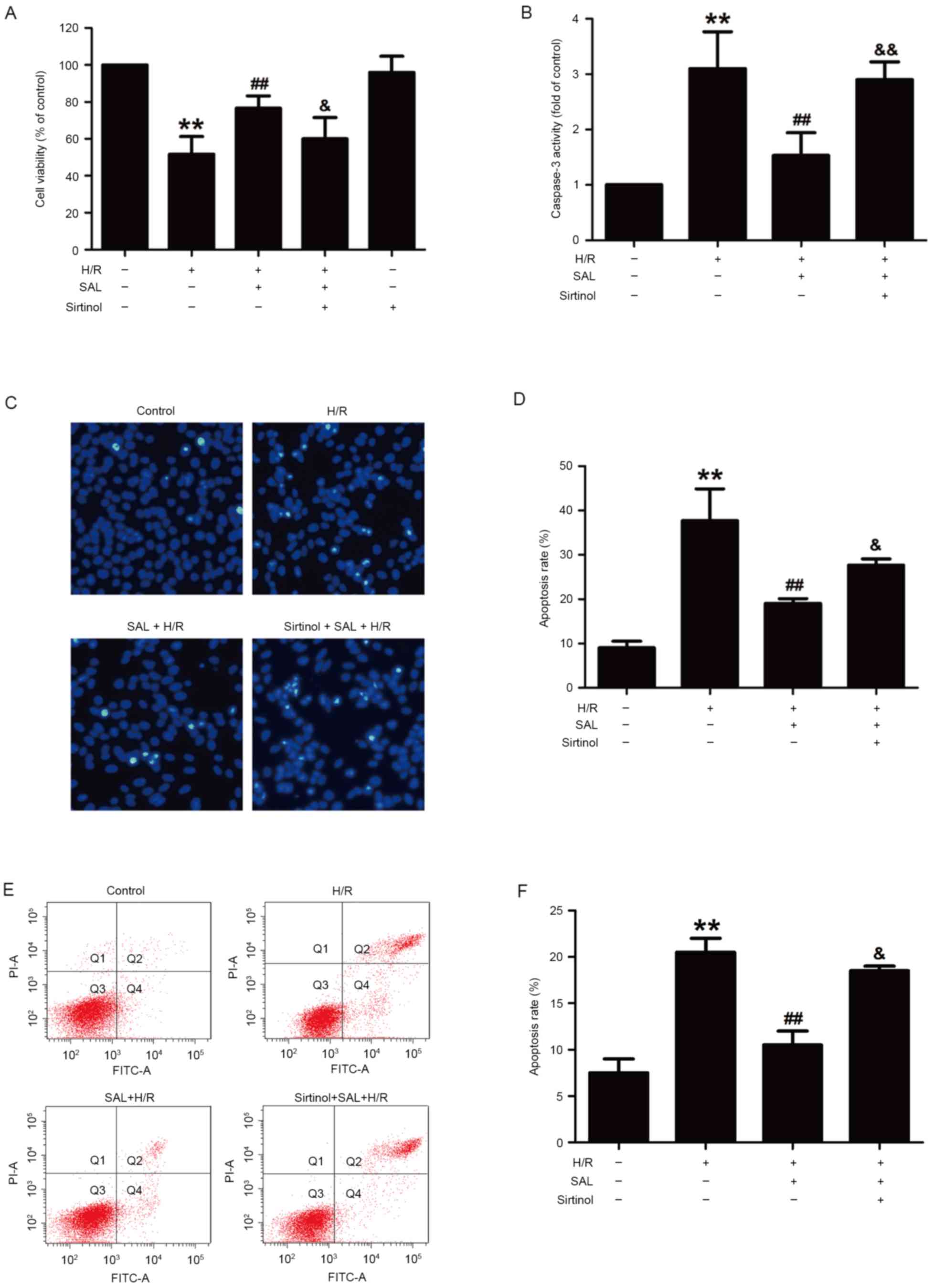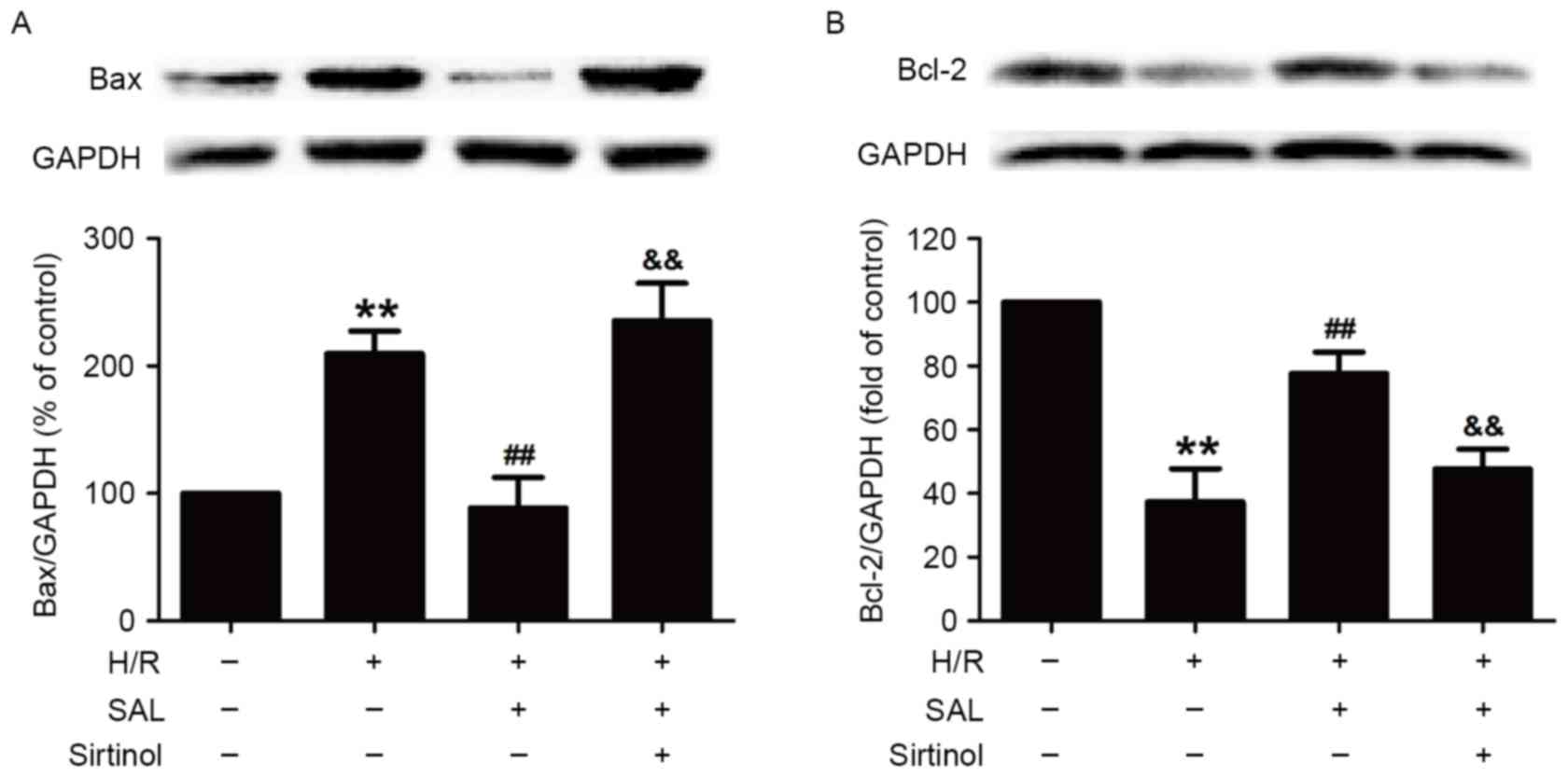|
1
|
Gao J, He H, Jiang W, Chang X, Zhu L, Luo
F, Zhou R, Ma C and Yan T: Salidroside ameliorates cognitive
impairment in a d-galactose-induced rat model of Alzheimer's
disease. Behav Brain Res. 293:27–33. 2015. View Article : Google Scholar : PubMed/NCBI
|
|
2
|
Yang SJ, Yu HY, Kang DY, Ma ZQ, Qu R, Fu Q
and Ma SP: Antidepressant-like effects of salidroside on olfactory
bulbectomy-induced pro-inflammatory cytokine production and
hyperactivity of HPA axis in rats. Pharmacol Biochem Behav.
124:451–457. 2014. View Article : Google Scholar : PubMed/NCBI
|
|
3
|
Xiao L, Li H, Zhang J, Yang F, Huang A,
Deng J, Liang M, Ma F, Hu M and Huang Z: Salidroside protects
Caenorhabditis elegans neurons from polyglutamine-mediated toxicity
by reducing oxidative stress. Molecules. 19:7757–7769. 2014.
View Article : Google Scholar : PubMed/NCBI
|
|
4
|
Xian H, Zhao J, Zheng Y, Wang M, Huang J,
Wu B, Sun C and Yang Y: MADP, a salidroside analog, protects
hippocampal neurons from glutamate induced apoptosis. Life Sci.
103:34–40. 2014. View Article : Google Scholar : PubMed/NCBI
|
|
5
|
Lipp LL: Brain perfusion and oxygenation.
Crit Care Nurs Clin North Am. 26:389–398. 2014. View Article : Google Scholar : PubMed/NCBI
|
|
6
|
Han J, Xiao Q, Lin YH, Zheng ZZ, He ZD, Hu
J and Chen LD: Neuroprotective effects of salidroside on focal
cerebral ischemia/reperfusion injury involve the nuclear erythroid
2-related factor 2 pathway. Neural Regen Res. 10:1989–1996. 2015.
View Article : Google Scholar : PubMed/NCBI
|
|
7
|
Barhwal K, Das SK, Kumar A, Hota SK and
Srivastava RB: Insulin receptor A and Sirtuin 1 synergistically
improve learning and spatial memory following chronic salidroside
treatment during hypoxia. J Neurochem. 135:332–346. 2015.
View Article : Google Scholar : PubMed/NCBI
|
|
8
|
Shi TY, Feng SF, Xing JH, Wu YM, Li XQ,
Zhang N, Tian Z, Liu SB and Zhao MG: Neuroprotective effects of
Salidroside and its analogue tyrosol galactoside against focal
cerebral ischemia in vivo and H2O2-induced neurotoxicity in vitro.
Neurotox Res. 21:358–367. 2012. View Article : Google Scholar : PubMed/NCBI
|
|
9
|
Zou YQ, Cai ZY, Mao YF, Li JB and Deng XM:
Effects of salidroside-pretreatment on neuroethology of rats after
global cerebral ischemia-reperfusion. Zhong Xi Yi Jie He Xue Bao.
7:130–134. 2009.(In Chinese). View Article : Google Scholar : PubMed/NCBI
|
|
10
|
Kiseleva TN and Chudin AV: Experimental
model of ocular ischemic diseases. Vestn Ross Akad Med Nauk.
97–103. 2014.(In Russian). View Article : Google Scholar : PubMed/NCBI
|
|
11
|
Dali-Youcef N, Lagouge M, Froelich S,
Koehl C, Schoonjans K and Auwerx J: Sirtuins: The ‘magnificent
seven’, function, metabolism and longevity. Ann Med. 39:335–345.
2007. View Article : Google Scholar : PubMed/NCBI
|
|
12
|
Pallàs M, Casadesús G, Smith MA,
Coto-Montes A, Pelegri C, Vilaplana J and Camins A: Resveratrol and
neurodegenerative diseases: Activation of SIRT1 as the potential
pathway towards neuroprotection. Curr Neurovasc Res. 6:70–81. 2009.
View Article : Google Scholar : PubMed/NCBI
|
|
13
|
Meng X, Tan J, Li M, Song S, Miao Y and
Zhang Q: Sirt1: Role Under the Condition of Ischemia/Hypoxia. Cell
Mol Neurobiol. 37:17–28. 2017. View Article : Google Scholar : PubMed/NCBI
|
|
14
|
Poulose N and Raju R: Sirtuin regulation
in aging and injury. Biochim Biophys Acta. 1852:2442–2455. 2015.
View Article : Google Scholar : PubMed/NCBI
|
|
15
|
Yang Y, Duan W, Li Y, Yan J, Yi W, Liang
Z, Wang N, Yi D and Jin Z: New role of silent information regulator
1 in cerebral ischemia. Neurobiol Aging. 34:2879–2888. 2013.
View Article : Google Scholar : PubMed/NCBI
|
|
16
|
Lin CH, Lin CC, Ting WJ, Pai PY, Kuo CH,
Ho TJ, Kuo WW, Chang CH, Huang CY and Lin WT: Resveratrol enhanced
FOXO3 phosphorylation via synergetic activation of SIRT1 and
PI3K/Akt signaling to improve the effects of exercise in elderly
rat hearts. Age (Dordr). 36:97052014. View Article : Google Scholar : PubMed/NCBI
|
|
17
|
Qin W, Zhao W, Ho L, Wang J, Walsh K,
Gandy S and Pasinetti GM: Regulation of forkhead transcription
factor FoxO3a contributes to calorie restriction-induced prevention
of Alzheimer's disease-type amyloid neuropathology and spatial
memory deterioration. Ann N Y Acad Sci. 1147:335–347. 2008.
View Article : Google Scholar : PubMed/NCBI
|
|
18
|
Peng K, Li Y, Long L, Li D, Jia Q, Wang Y,
Shen Q, Tang Y, Wen L, Kung HF and Peng Y: Knockdown of FoxO3a
induces increased neuronal apoptosis during embryonic development
in zebrafish. Neurosci Lett. 484:98–103. 2010. View Article : Google Scholar : PubMed/NCBI
|
|
19
|
Mojsilovic-Petrovic J, Nedelsky N,
Boccitto M, Mano I, Georgiades SN, Zhou W, Liu Y, Neve RL, Taylor
JP, Driscoll M, et al: FOXO3a is broadly neuroprotective in vitro
and in vivo against insults implicated in motor neuron diseases. J
Neurosci. 29:8236–8247. 2009. View Article : Google Scholar : PubMed/NCBI
|
|
20
|
Kops GJ, Dansen TB, Polderman PE, Saarloos
I, Wirtz KW, Coffer PJ, Huang TT, Bos JL, Medema RH and Burgering
BM: Forkhead transcription factor FOXO3a protects quiescent cells
from oxidative stress. Nature. 419:316–321. 2002. View Article : Google Scholar : PubMed/NCBI
|
|
21
|
Avraham Y, Davidi N, Porat M, Chernoguz D,
Magen I, Vorobeiv L, Berry EM and Leker RR: Leptin reduces infarct
size in association with enhanced expression of CB2, TRPV1, SIRT-1
and leptin receptor. Curr Neurovasc Res. 7:136–143. 2010.
View Article : Google Scholar : PubMed/NCBI
|
|
22
|
Zhu HR, Wang ZY, Zhu XL, Wu XX, Li EG and
Xu Y: Icariin protects against brain injury by enhancing
SIRT1-dependent PGC-1alpha expression in experimental stroke.
Neuropharmacology. 59:70–76. 2010. View Article : Google Scholar : PubMed/NCBI
|
|
23
|
Wang T, Gu J, Wu PF, Wang F, Xiong Z, Yang
YJ, Wu WN, Dong LD and Chen JG: Protection by tetrahydroxystilbene
glucoside against cerebral ischemia: Involvement of JNK, SIRT1, and
NF-kappaB pathways and inhibition of intracellular ROS/RNS
generation. Free Radic Biol Med. 47:229–240. 2009. View Article : Google Scholar : PubMed/NCBI
|
|
24
|
Livak KJ and Schmittgen TD: Analysis of
relative gene expression data using real-time quantitative PCR and
the 2(-Delta Delta C(T)) method. Methods. 25:402–408. 2001.
View Article : Google Scholar : PubMed/NCBI
|
|
25
|
Chen X, Deng A, Zhou T and Ding F:
Pretreatment with
2-(4-methoxyphenyl)ethyl-2-acetamido-2-deoxy-β-D-pyranoside
attenuates cerebral ischemia/reperfusion-induced injury in vitro
and in vivo. PLoS One. 1:e1001262014. View Article : Google Scholar
|
|
26
|
Han T: Effects of salidroside pretreatment
on expression of tumor necrosis factor-alpha and permeability of
blood brain barrier in rat model of focal
cerebralischemia-reperfusion injury. Asian Pac J Trop Med.
6:156–158. 2013. View Article : Google Scholar : PubMed/NCBI
|
|
27
|
Koronowski KB and Perez-Pinzon MA: Sirt1
in cerebral ischemia. Brain Circ. 1:69–78. 2015. View Article : Google Scholar : PubMed/NCBI
|
|
28
|
Nakka VP, Gusain A, Mehta SL and Raghubir
R: Molecular mechanisms of apoptosis in cerebral ischemia: Multiple
neuroprotective opportunities. Mol Neurobiol. 37:7–38. 2008.
View Article : Google Scholar : PubMed/NCBI
|
|
29
|
Zhao JJ, Song JQ, Pan SY and Wang K:
Treatment with isorhamnetin protects the brain against ischemic
injury in mice. Neurochem Res. 41:1939–1948. 2016. View Article : Google Scholar : PubMed/NCBI
|
|
30
|
Ahn SM, Kim HN, Kim YR, Choi YW, Kim CM,
Shin HK and Choi BT: Emodin from Polygonum multiflorum ameliorates
oxidative toxicity in HT22 cells and deficits in photothrombotic
ischemia. J Ethnopharmacol. 188:13–20. 2016. View Article : Google Scholar : PubMed/NCBI
|
|
31
|
Elmore S: Apoptosis: A review of
programmed cell death. Toxicol Pathol. 35:495–516. 2007. View Article : Google Scholar : PubMed/NCBI
|
|
32
|
Guo Y, Zhao Y, Zheng C, Meng Y and Yang Y:
Synthesis, biological activity of salidroside and its analogues.
Chem Pharm Bull (Tokyo). 58:1627–1629. 2010. View Article : Google Scholar : PubMed/NCBI
|
|
33
|
Lai W, Zheng Z, Zhang X, Wei Y, Chu K,
Brown J, Hong G and Chen L: Salidroside-mediated neuroprotection is
associated with induction of early growth response genes (Egrs)
across a wide therapeutic window. Neurotox Res. 28:108–121. 2015.
View Article : Google Scholar : PubMed/NCBI
|
|
34
|
Shi N, Zhu C and Li L: Rehabilitation
training and resveratrol improve the recovery of neurological and
motor function in rats after cerebral ischemic injury through the
Sirt1 signaling pathway. Biomed Res Int. 2016:17321632016.
View Article : Google Scholar : PubMed/NCBI
|
|
35
|
Lu H and Wang B: SIRT1 exerts
neuroprotective effects by attenuating cerebral
ischemia/reperfusion-induced injury via targeting p53/microRNA-22.
Int J Mol Med. 39:208–216. 2017. View Article : Google Scholar : PubMed/NCBI
|
|
36
|
Mellini P, Valente S and Mai A: Sirtuin
modulators: An updated patent review (2012–2014). Expert Opin Ther
Pat. 25:5–15. 2015.PubMed/NCBI
|
|
37
|
Xue F, Huang JW, Ding PY, Zang HG, Kou ZJ,
Li T, Fan J, Peng ZW and Yan WJ: Nrf2/antioxidant defense pathway
is involved in the neuroprotective effects of Sirt1 against focal
cerebral ischemia in rats after hyperbaric oxygen preconditioning.
Behav Brain Res. 309:1–8. 2016. View Article : Google Scholar : PubMed/NCBI
|
|
38
|
Hsu CP, Zhai P, Yamamoto T, Maejima Y,
Matsushima S, Hariharan N, Shao D, Takagi H, Oka S and Sadoshima J:
Silent information regulator 1 protects the heart from
ischemia/reperfusion. Circulation. 122:2170–2182. 2010. View Article : Google Scholar : PubMed/NCBI
|
|
39
|
de Kreutzenberg SV, Ceolotto G, Papparella
I, Bortoluzzi A, Semplicini A, Dalla Man C, Cobelli C, Fadini GP
and Avogaro A: Downregulation of the longevity-associated protein
sirtuin 1 in insulin resistance and metabolic syndrome: Potential
biochemical mechanisms. Diabetes. 59:1006–1015. 2010. View Article : Google Scholar : PubMed/NCBI
|
|
40
|
Lv H, Wang L, Shen J, Hao S, Ming A, Wang
X, Su F and Zhang Z: Salvianolic acid B attenuates apoptosis and
inflammation via SIRT1 activation in experimental stroke rats.
Brain Res Bull. 115:30–36. 2015. View Article : Google Scholar : PubMed/NCBI
|
|
41
|
Lam EW, Francis RE and Petkovic M: FOXO
transcription factors: Key regulators of cell fate. Biochem Soc
Trans. 34:722–726. 2006. View Article : Google Scholar : PubMed/NCBI
|
|
42
|
Gomes AR, Yong JS, Kiew KC, Aydin E,
Khongkow M, Laohasinnarong S and Lam EW: Sirtuin1 (SIRT1) in the
acetylation of downstream target proteins. Methods Mol Biol.
1436:169–188. 2016. View Article : Google Scholar : PubMed/NCBI
|
|
43
|
Zakhary SM, Ayubcha D, Dileo JN, Jose R,
Leheste JR, Horowitz JM and Torres G: Distribution analysis of
deacetylase SIRT1 in rodent and human nervous systems. Anat Rec
(Hoboken). 293:1024–1032. 2010. View Article : Google Scholar : PubMed/NCBI
|
|
44
|
Fukunaga K and Shioda N:
Pathophysiological relevance of forkhead transcription factors in
brain ischemia. Adv Exp Med Biol. 665:130–142. 2009. View Article : Google Scholar : PubMed/NCBI
|
|
45
|
Wang XX, Wang XL, Tong MM, Gan L, Chen H,
Wu SS, Chen JX, Li RL, Wu Y, Zhang HY, et al: SIRT6 protects
cardiomyocytes against ischemia/reperfusion injury by augmenting
FoxO3α-dependent antioxidant defense mechanisms. Basic Res Cardiol.
111:132016. View Article : Google Scholar : PubMed/NCBI
|
|
46
|
Zheng F, Tang Q, Wu J, Zhao S, Liang Z, Li
L, Wu W and Hann S: p38α MAPK-mediated induction and interaction of
FOXOa and p contribute to the inhibited-growth and
induced-apoptosis of human lung adenocarcinoma cells by berberine.
J Exp Clin Cancer Res. 33:362014. View Article : Google Scholar : PubMed/NCBI
|
|
47
|
Della-Morte D, Dave KR, DeFazio RA, Bao
YC, Raval AP and Perez-Pinzon MA: Resveratrol pretreatment protects
rat brain from cerebral ischemic damage via a sirtuin 1-uncoupling
protein 2 pathway. Neuroscience. 159:993–1002. 2009. View Article : Google Scholar : PubMed/NCBI
|
|
48
|
Lee JH, Moon JH, Nazim UM, Lee YJ, Seol
JW, Eo SK, Lee JH and Park SY: Melatonin protects skin keratinocyte
from hydrogen peroxide-mediated cell death via the SIRT1 pathway.
Oncotarget. 7:12075–12088. 2016. View Article : Google Scholar : PubMed/NCBI
|
|
49
|
Yu L, Li Q, Yu B, Yang Y, Jin Z, Duan W,
Zhao G, Zhai M, Liu L, Yi D, et al: Berberine attenuates myocardial
ischemia/reperfusion injury by reducing oxidative stress and
inflammation response: Role of silent information regulator 1. Oxid
Med Cell Longev. 2016:16896022016. View Article : Google Scholar : PubMed/NCBI
|
|
50
|
Zheng JH, Viacava Follis A, Kriwacki RW
and Moldoveanu T: Discoveries and controversies in BCL-2
protein-mediated apoptosis. FEBS J. 283:2690–2700. 2016. View Article : Google Scholar : PubMed/NCBI
|
|
51
|
Gross A: BCL-2 family proteins as
regulators of mitochondria metabolism. Biochim Biophys Acta.
1857:1243–1246. 2016. View Article : Google Scholar : PubMed/NCBI
|
|
52
|
Broughton BR, Reutens DC and Sobey CG:
Apoptotic mechanisms after cerebral ischemia. Stroke. 40:e331–e339.
2009. View Article : Google Scholar : PubMed/NCBI
|



